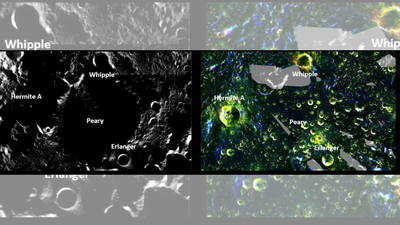BENGALURU: Isro Saturday released a set of advanced data products derived from Chandrayaan-2’s (CH2) radar observations, offering new insights into the Moon’s polar regions, including on potential water-ice deposits.The orbiter, in lunar orbit since 2019, carries the Dual Frequency Synthetic Aperture Radar (DFSAR), which has provided high-resolution, full-polarimetric data at 25 metres per pixel.DFSAR transmits and receives radar signals in both vertical and horizontal directions, making it particularly suited to examine the Moon’s surface and subsurface properties. Using around 1,400 radar datasets, scientists at the Space Applications Centre (SAC), Ahmedabad, have generated polarimetric mosaics covering latitudes 80 to 90 degrees in both hemispheres.

Figure: (Left) Optical and (Right) DFSAR Image of Peary Crater region in Lunar North Pole, from a section marked on the mosaic.
The derived products provide information on potential water-ice deposits, surface roughness, and dielectric constant—a measure of surface density and porosity. These datasets are processed using algorithms developed indigenously by Isro, producing ready-to-use outputs for the scientific community.“This is a first-order resource for understanding the Moon’s polar regions, which are believed to preserve the early chemical conditions of the solar system,” Isro said. The data products complement existing hyperspectral observations, helping researchers study mineral distributions and surface characteristics more comprehensively.As per Isro, the polar mosaics include key radar parameters. “Circular Polarisation Ratio (CPR) indicates possible water-ice presence. Single bounce Eigenvalue Relative Difference (SERD) represents surface roughness. T-Ratio is related to the dielectric constant of the material and Polarimetric decomposition components highlight different types of radar scattering, including Odd, Even, Volume, and Helix,” Isro said.The Level 3C polar mosaic products are freely available for download on Isro’s Indian Space Science Data Centre (ISSDC) PRADAN portal. Users can visualise the data in CH2 MapBrowse for detailed exploration of the lunar north and south poles, including regions such as Peary Crater in the north.Isro has encouraged researchers and students worldwide to explore these datasets, which are expected to inform future lunar exploration missions and studies of planetary evolution.



